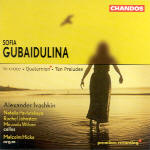Tatar-Russian composer Sofia Gubaidulina often has been attracted to the colors of stringed instruments, from the Western classical string quartet to the Japanese koto. That longtime fascination flourishes on this disc that zeroes in on her repertoire for cello, whether it’s played alone (in the 10 Preludes), in a group setting (Quaternion for cello quartet, which receives its debut recording here), or juxtaposed with another instrument (In croce for cello and organ).
Gubaidulina often is portrayed as a composer of great austerity, but that’s a too-easy generalization belied by what we hear in these pieces. In the 10 Preludes–each of which requires a different technique from the soloist, from a whistling sul ponticello to an entirely plucked closing prelude–we hear suggestions of luxuriously rich color evoked by each facet of the cello’s tone. The simplicity and clarity of Gubaidulina’s melodies may tend to be stark, but the sum experience is as austere (or not) as the icons of her Russian Orthodox heritage: the expressions on the saints’ faces are certainly severe, but that harshness is softened by great quantities of gold and jewels that surround the figures.
As you might expect, the Christian mysticism that pervades Gubaidulina’s work is abundant here. The title of In croce suggests not only the criss-crossing between cello and organ (or cello and the Russian bayan accordion, in another version of this work), but also the religious image “on the cross”. The unusual tonality of the four-cello Quaternion demands that two of the cellos be tuned one quarter-tone below the other two, which the composer sees as a suggestion of interaction between the human and the divine, and it definitely creates an off-kilter, dreamlike environment for the listener.
The performances are generally excellent; Alexander Ivashkin performs Gubaidulina’s music with impressive technical accuracy and emotional fluidity, ranging from the tender to the bracing, particularly in the Preludes. The Quaternion players seem more a single organism than four discrete musicians–their precision and matched tone and intensity, sustained for the 22-minute piece, are remarkable. The one slightly off pairing is the one with organist Malcolm Hicks, whose approach to In croce is much more strident than his partner’s. Maybe it’s due to Chandos’ sound (in which the organ is surprisingly forward), but Hicks’ instrument, which is supposed to be turned off near the end of the piece to allow the sound to dissipate slowly, instead comes across as a menacing, ominously rumbling presence next to a sweetly ringing cello.
































